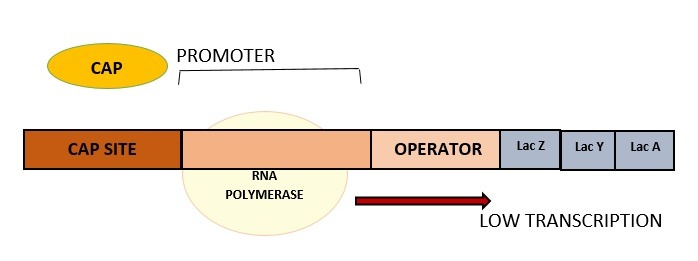Lac Operon- An Inducible Operon
Introduction
- The sequence of bases coding for one or more polypeptides, to gather with the promoter and operator or activator – binding sites, is called an Operon.
- Operons that includes 2-6 genes transcribed as a unit are common.
- Operons demonstrate different ways that the regulatory proteins can be used to control gene expression at the level of transcription initiation.
- Operon are the feature of prokaryotes only.
Operon has two components
-
- Structural gene
- Regulatory gene
- Lac operon or the lactose operon is the cluster of gene which controls the enzyme productions needed for catabolism (breakdown) of lactose.
- The lactose operon is an example of an inducible operon.
- Lac operon acts like a switch i.e. when the lactose is present, then operon is ON and when lactose is absent then the operon is OFF.
- In this the genes are transcribed as a single mRNA, and are controlled under one promoter.
- Lac operon was to be first showed by Francois Jacob & Jacques Monod in 1959, for which they had received noble prize also.
- They developed the concept of an operon, and results in the lactose operon of E.coli which is probably the best studied negative control system.
- This operon is required for the transport and metabolism of lactose in E.coli and other enteric bacteria.
- The lac operon only works when lactose is present and the glucose is absent i.e. its totally wasteful to synthesize enzymes of the lactose operon when the lactose is unavailable.
Lac Operon model
- Structural gene: They are the genes are coding for non – regulatory polypeptides (eg. Enzymes).
- Regulatory gene: These genes encodes the products that regulate gene expression. It only helps in the ON /OFF mechanism of the lac operon. It includes the promoter, operator and the inhibitor.
- Promoter (lac p): They acts as the binding site for RNA polymerase, where the enzymes performs transcription.
- Operator (lac o): They are the binding site for the repressor. It acts as a segment between the promoter and the genes of the operon.
- Repressor (lac i): It codes for the repressor protein. They bind to DNA at the operator and blocks the binding of RNA Polymerase at the promoter. They acts as lactose sensor. They inhibits the transcription of the lac operon.
- CAP protein: CAP stands for catabolite Activator Protein. It acts as glucose sensor.They activates the transcription in the operon but only when there is low level of glucose.
- Inducer: They are small molecule that either activates or inhibits the transcription by collaborating with a repressor or an activator.
- RNA Polymerase: They are used to recognize or bind promoters, melt the DNA and initiate RNA synthesis.
The lac operon model contains 3 structural genes, controlled by the lac repressor, which is encoded by Lac i.
The three structural genes are:
-
- β-galactosidase (lac Z)
- β-galactosidase permease (lac Y)
- β-galactosidase transacetylase (lac A)

- First gene for β-galactosidase (lac Z): It hydrolyses lactose to Glucose and galactose).
- Second gene β-galactosidase permease (lac Y): This gene directs the synthesis of β-galactosidase Permease, and hence protein is Responsible for lactose uptake. It transfers lactose into the E.coli cells ).
- Third gene β-galactosidase Transcetylase (lac A) : It transfers trans Acetyl CoA to the β-galactoside. Toxic thiogalactoside transported out of the cell.
Mechanism of Lac Operon
Case 1
When repressor bound to operator: No transcription of lac Z, lac Y, lac A.

Lactose Absent:
In the absence of the lactose: The lac repressor (lac i) will bind to the operator site of the lac operon. So, the RNA polymerase will not be to transcribe the structural gene and Hence, no transcription will take place.
Case 2
When repressor bound to the inducer: Active transcription of lac Z, lac Y, lac A.

Lactose Present:
In the presence of the lactose: The lac repressor (lac i) is released from the operator site and the, Lactose molecule will bind with the repressor protein. Now the RNA Polymerase will bind to the promoter site and thus the genes are then Transcribed.
Case 3
Glucose absent:

In the Absence of glucose: when the glucose is present in the low amount, cAMP is produced. Now, the cAMP attaches with the CAP, and allow it to bind with the DNA. CAP Helps the RNA polymerase to bind to the promoter, and thus results. In the high level of transcription.
Case 4
Glucose present:

In the presence of glucose: when the glucose is present in the high amount, no cAMP is formed. Now, the CAP will not bind to the DNA without the cAMP, So transcription will Occur in very less amount.
References and Sources
- https://www.slideshare.net/kirtimehta16/transcriptional-and-post-transcriptional-regulation-of-geneexpression-71990927
- https://link.springer.com/article/10.1007/s12064-007-0012-x
- https://www.saburchill.com/IBbiology/chapters01/030.html
- https://www.yourarticlelibrary.com/biology/lac-operon-inducible-operon-and-repressible-operon-biology/27189
- https://en.m.wikipedia.org/wiki/Lac_operon
Overview of lac Operon, An Inducible Operon
Also Read:
- Vector: properties, types and characteristics
- Histones
- Nitrogen Cycle
- What is Gene Expression?
- Carbohydrate: Structure, Functions and Types
- Overview of Glucose Catabolism via Glycolysis
- Tryptophan Operon: History, Structure, Regulation and Attenuation
- Transcription in prokaryotes: Initiation, Elongation and Termination
- Milk: Composition, Processing, Pasteurization, Pathogens and Spoilage
